調制信號識別系列 (一):基準模型
說明:本文包含對CNN和CNN+LSTM基準模型的復現,模型架構參考下述兩篇文章
文章目錄
- 調制信號識別系列 (一):基準模型
- 一、論文
- 1、DL-PR: Generalized automatic modulation classification method based on deep learning with priori regularization
- 2、A Deep Learning Approach for Modulation Recognition via Exploiting Temporal Correlations
- 二、流程
- 1、數據加載
- 2、訓練測試
- 3、可視化
- 三、模型
- 1、CNN
- 2、CNN+LSTM(DL-PR)
- 3、CNN+LSTM
- 四、對比
- 1、論文1
- 2、論文2
- 五、總結
一、論文
1、DL-PR: Generalized automatic modulation classification method based on deep learning with priori regularization
- https://www.sciencedirect.com/science/article/pii/S095219762300266X

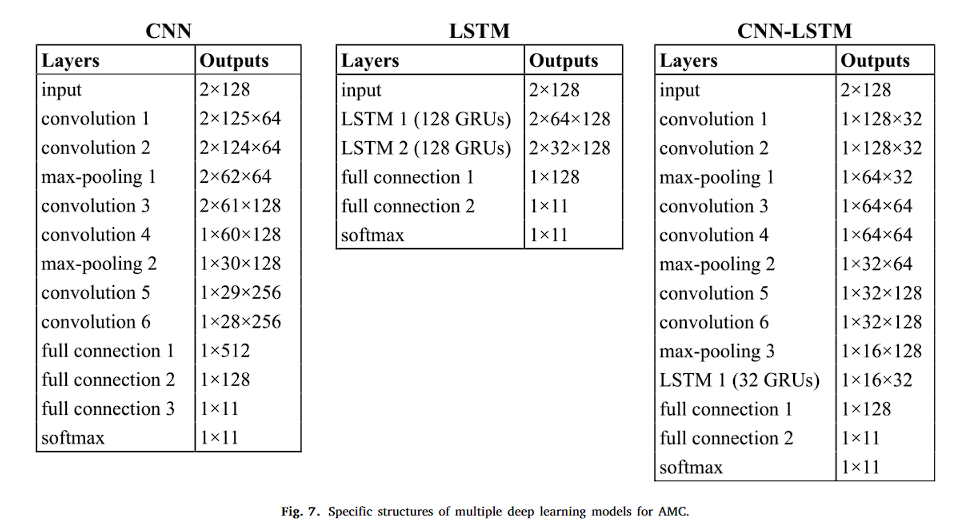
2、A Deep Learning Approach for Modulation Recognition via Exploiting Temporal Correlations
-
2018 IEEE 19th International Workshop on Signal Processing Advances in Wireless Communications (SPAWC)
-
https://ieeexplore.ieee.org/abstract/document/8445938
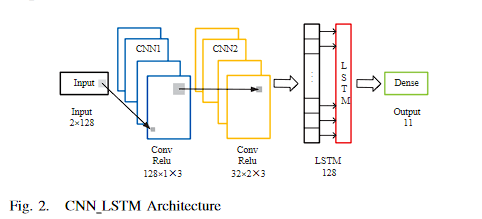
Note that before each convolutional layer, we use the zero-padding method to control the spatial size of the output volumes. Specifically, we pad the input volume with two zeros around the border, thus the output volume of the second convolutional layer is of size 32 × 132. We then take 32 as the dimensionality of the input and 132 as the time steps in LSTM layer. Dropout method is also used to prevent the neural network from overfitting. Compared to architecture in [12], we can see that we replace the third dense fully-connected layer with a LSTM layer. Our simulations suggest that this replacement not only reduces the number of parameters by an order of magnitude, but also leads to a significant performance improvement.
請注意,在每個卷積層之前,我們使用零填充方法來控制輸出卷的空間大小。具體來說,我們在輸入量的邊界周圍填充兩個零,因此第二個卷積層的輸出量的大小為 32 × 132。然后我們將 32 作為輸入的維度,將 132 作為 LSTM 層的時間步長。 Dropout方法也用于防止神經網絡過擬合。與[12]中的架構相比,我們可以看到我們用 LSTM 層替換了第三個密集全連接層。我們的模擬表明,這種替換不僅將參數數量減少了一個數量級,而且還帶來了顯著的性能改進。
二、流程
1、數據加載
import torch
import torch.nn as nn
import torch.optim as optim
from torch.utils.data import DataLoader, TensorDataset, random_split
import pandas as pd
import numpy as np
import matplotlib.pyplot as plt
from sklearn.metrics import confusion_matrix, ConfusionMatrixDisplay
from torchsummary import summary
# 加載數據
csv_file_path = 'snr_data/output_data_snr_6.csv'
data_frame = pd.read_csv(csv_file_path)# 提取前256列數據并轉換為張量
vectors = torch.tensor(data_frame.iloc[:, :256].values, dtype=torch.float32)# 將256維向量轉換為2x128的矩陣形式
vectors = vectors.view(-1, 2, 128)# 劃分訓練集和測試集索引
train_size = int(0.8 * len(vectors))
test_size = len(vectors) - train_size
train_indices, test_indices = random_split(range(len(vectors)), [train_size, test_size])# 使用訓練集的統計量進行歸一化
train_vectors = vectors[train_indices]# 對IQ分量分別進行歸一化
train_mean_I = train_vectors[:, 0, :].mean(dim=0, keepdim=True)
train_std_I = train_vectors[:, 0, :].std(dim=0, keepdim=True)train_mean_Q = train_vectors[:, 1, :].mean(dim=0, keepdim=True)
train_std_Q = train_vectors[:, 1, :].std(dim=0, keepdim=True)# 歸一化整個數據集
vectors[:, 0, :] = (vectors[:, 0, :] - train_mean_I) / train_std_I
vectors[:, 1, :] = (vectors[:, 1, :] - train_mean_Q) / train_std_Q# 提取Mod_Type列并轉換為數值標簽
mod_types = data_frame['Mod_Type'].astype('category').cat.codes.values
labels = torch.tensor(mod_types, dtype=torch.long)# 創建TensorDataset
dataset = TensorDataset(vectors, labels)# 創建訓練集和測試集
train_dataset = TensorDataset(vectors[train_indices], labels[train_indices])
test_dataset = TensorDataset(vectors[test_indices], labels[test_indices])# 創建DataLoader
train_loader = DataLoader(train_dataset, batch_size=32, shuffle=True)
test_loader = DataLoader(test_dataset, batch_size=32, shuffle=False)
# 替換模型架構
2、訓練測試
criterion = nn.CrossEntropyLoss()
optimizer = optim.Adam(model.parameters(), lr=0.001)
num_epochs = 50
train_losses = []
test_losses = []
train_accuracies = []
test_accuracies = []def calculate_accuracy(outputs, labels):_, predicted = torch.max(outputs, 1)total = labels.size(0)correct = (predicted == labels).sum().item()return correct / totalfor epoch in range(num_epochs):# 訓練階段model.train()running_loss = 0.0correct = 0total = 0for inputs, labels in train_loader:inputs = inputs.to(device)labels = labels.to(device)optimizer.zero_grad()outputs = model(inputs)loss = criterion(outputs, labels)loss.backward()optimizer.step()running_loss += loss.item()correct += (outputs.argmax(1) == labels).sum().item()total += labels.size(0)train_loss = running_loss / len(train_loader)train_accuracy = correct / totaltrain_losses.append(train_loss)train_accuracies.append(train_accuracy)# 測試階段model.eval()running_loss = 0.0correct = 0total = 0with torch.no_grad():for inputs, labels in test_loader:inputs = inputs.to(device)labels = labels.to(device)outputs = model(inputs)loss = criterion(outputs, labels)running_loss += loss.item()correct += (outputs.argmax(1) == labels).sum().item()total += labels.size(0)test_loss = running_loss / len(test_loader)test_accuracy = correct / totaltest_losses.append(test_loss)test_accuracies.append(test_accuracy)print(f"Epoch [{epoch+1}/{num_epochs}], Train Loss: {train_loss:.4f}, Train Accuracy: {train_accuracy:.4f}, Test Loss: {test_loss:.4f}, Test Accuracy: {test_accuracy:.4f}")print("Training complete.")3、可視化
epochs = range(1, num_epochs + 1)plt.figure(figsize=(12, 5))# 繪制損失圖像
plt.subplot(1, 2, 1)
plt.plot(epochs, train_losses, label='Train Loss')
plt.plot(epochs, test_losses, label='Test Loss')
plt.xlabel('Epoch')
plt.ylabel('Loss')
plt.legend()
plt.title('Loss vs. Epochs')# 繪制準確率圖像
plt.subplot(1, 2, 2)
plt.plot(epochs, train_accuracies, label='Train Accuracy')
plt.plot(epochs, test_accuracies, label='Test Accuracy')
plt.xlabel('Epoch')
plt.ylabel('Accuracy')
plt.legend()
plt.title('Accuracy vs. Epochs')plt.show()三、模型
說明:下述模型均在SNR=6dB RadioML2016.10a數據集下的實驗結果,僅使用原始的IQ分量信息,未使用數據增強,也未進行調參
1、CNN
class CNNModel(nn.Module):def __init__(self):super(CNNModel, self).__init__()self.conv1 = nn.Conv2d(1, 64, (1, 4), stride=1)self.conv2 = nn.Conv2d(64, 64, (1, 2), stride=1)self.pool1 = nn.MaxPool2d((1, 2))self.conv3 = nn.Conv2d(64, 128, (1, 2), stride=1)self.conv4 = nn.Conv2d(128, 128, (2, 2), stride=1)self.pool2 = nn.MaxPool2d((1, 2))self.conv5 = nn.Conv2d(128, 256, (1, 2), stride=1)self.conv6 = nn.Conv2d(256, 256, (1, 2), stride=1)self.fc1 = nn.Linear(256 * 1 * 28, 512)self.fc2 = nn.Linear(512, 128)self.fc3 = nn.Linear(128, 11)def forward(self, x):x = x.unsqueeze(1) # 添加通道維度x = torch.relu(self.conv1(x))x = torch.relu(self.conv2(x))x = self.pool1(x)x = torch.relu(self.conv3(x))x = torch.relu(self.conv4(x))x = self.pool2(x)x = torch.relu(self.conv5(x))x = torch.relu(self.conv6(x))x = x.view(x.size(0), -1)x = torch.relu(self.fc1(x))x = torch.relu(self.fc2(x))x = self.fc3(x)return xmodel = CNNModel()
summary(model, (2, 128))

----------------------------------------------------------------Layer (type) Output Shape Param #
================================================================Conv2d-1 [-1, 64, 2, 125] 320Conv2d-2 [-1, 64, 2, 124] 8,256MaxPool2d-3 [-1, 64, 2, 62] 0Conv2d-4 [-1, 128, 2, 61] 16,512Conv2d-5 [-1, 128, 1, 60] 65,664MaxPool2d-6 [-1, 128, 1, 30] 0Conv2d-7 [-1, 256, 1, 29] 65,792Conv2d-8 [-1, 256, 1, 28] 131,328Linear-9 [-1, 512] 3,670,528Linear-10 [-1, 128] 65,664Linear-11 [-1, 11] 1,419
================================================================
Total params: 4,025,483
Trainable params: 4,025,483
Non-trainable params: 0
----------------------------------------------------------------
Input size (MB): 0.00
Forward/backward pass size (MB): 0.63
Params size (MB): 15.36
Estimated Total Size (MB): 15.98
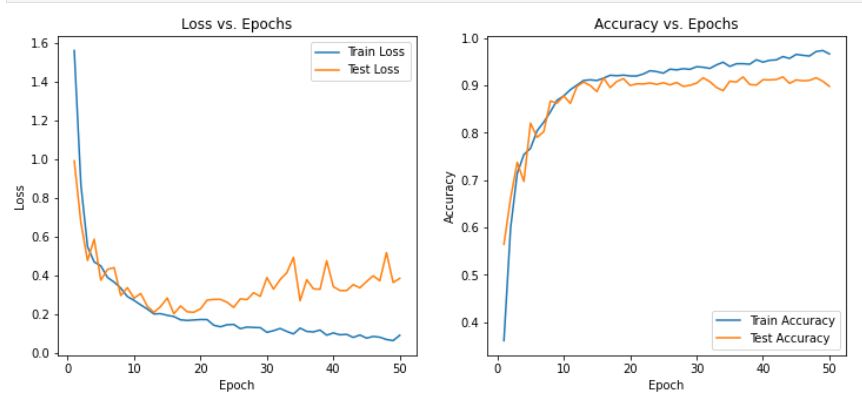
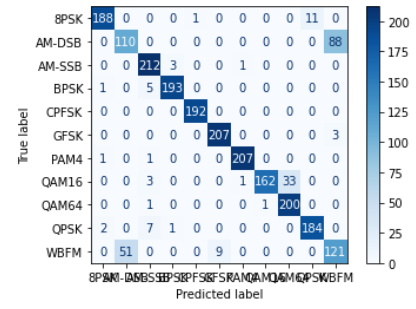
2、CNN+LSTM(DL-PR)
import torch
import torch.nn as nnclass CNNLSTMModel(nn.Module):def __init__(self):super(CNNLSTMModel, self).__init__()self.conv1 = nn.Conv2d(1, 32, (2, 3), stride=1, padding=(0,1)) # Adjusted input channels and filtersself.conv2 = nn.Conv2d(32, 32, (1, 3), stride=1, padding=(0,1))self.pool1 = nn.MaxPool2d((1, 2))self.conv3 = nn.Conv2d(32, 64, (1, 3), stride=1, padding=(0,1))self.conv4 = nn.Conv2d(64, 64, (1, 3), stride=1, padding=(0,1))self.pool2 = nn.MaxPool2d((1, 2))self.conv5 = nn.Conv2d(64, 128, (1, 3), stride=1, padding=(0,1))self.conv6 = nn.Conv2d(128, 128, (1, 3), stride=1, padding=(0,1))self.pool3 = nn.MaxPool2d((1, 2))self.lstm = nn.LSTM(128, 32, batch_first=True) # Adjusted input size and LSTM hidden sizeself.fc1 = nn.Linear(32, 128)self.fc2 = nn.Linear(128, 11)def forward(self, x):#print("x:",x.shape)if x.dim() == 3:x = x.unsqueeze(1) # 假設x的形狀是[2, 128], 這將改變它為[1, 2, 128]#print("x.unsqueeze(0):",x.shape)x = torch.relu(self.conv1(x))x = torch.relu(self.conv2(x))x = self.pool1(x)x = torch.relu(self.conv3(x))x = torch.relu(self.conv4(x))x = self.pool2(x)x = torch.relu(self.conv5(x))x = torch.relu(self.conv6(x))x = self.pool3(x)# Prepare input for LSTMx = x.view(x.size(0), 16, 128) # Adjusted view#print(x.shape)x, (hn, cn) = self.lstm(x)x = x[:, -1, :] # Get the last output of the LSTMx = torch.relu(self.fc1(x))x = self.fc2(x)return xmodel = CNNLSTMModel()
summary(model,input_size=(1, 2, 128))

==========================================================================================
Layer (type:depth-idx) Output Shape Param #
==========================================================================================
CNNLSTMModel [1, 11] --
├─Conv2d: 1-1 [1, 32, 1, 128] 224
├─Conv2d: 1-2 [1, 32, 1, 128] 3,104
├─MaxPool2d: 1-3 [1, 32, 1, 64] --
├─Conv2d: 1-4 [1, 64, 1, 64] 6,208
├─Conv2d: 1-5 [1, 64, 1, 64] 12,352
├─MaxPool2d: 1-6 [1, 64, 1, 32] --
├─Conv2d: 1-7 [1, 128, 1, 32] 24,704
├─Conv2d: 1-8 [1, 128, 1, 32] 49,280
├─MaxPool2d: 1-9 [1, 128, 1, 16] --
├─LSTM: 1-10 [1, 16, 32] 20,736
├─Linear: 1-11 [1, 128] 4,224
├─Linear: 1-12 [1, 11] 1,419
==========================================================================================
Total params: 122,251
Trainable params: 122,251
Non-trainable params: 0
Total mult-adds (M): 4.32
==========================================================================================
Input size (MB): 0.00
Forward/backward pass size (MB): 0.20
Params size (MB): 0.49
Estimated Total Size (MB): 0.69
==========================================================================================
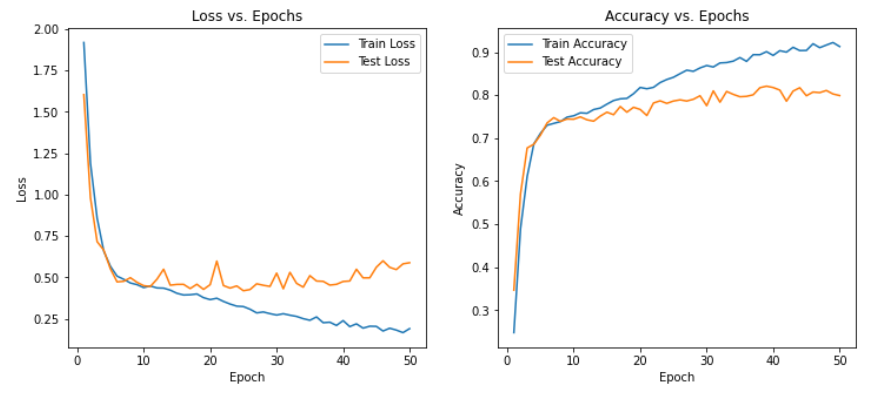

3、CNN+LSTM
# 定義結合CNN和LSTM的模型
class CNNLSTMModel(nn.Module):def __init__(self):super(CNNLSTMModel, self).__init__()self.conv1 = nn.Conv2d(1, 64, (1, 4), stride=1)self.conv2 = nn.Conv2d(64, 64, (1, 2), stride=1)self.pool1 = nn.MaxPool2d((1, 2))self.conv3 = nn.Conv2d(64, 128, (1, 2), stride=1)self.conv4 = nn.Conv2d(128, 128, (2, 2), stride=1)self.pool2 = nn.MaxPool2d((1, 2))self.conv5 = nn.Conv2d(128, 256, (1, 2), stride=1)self.conv6 = nn.Conv2d(256, 256, (1, 2), stride=1)self.lstm = nn.LSTM(256, 128, batch_first=True)self.fc1 = nn.Linear(128, 512)self.fc2 = nn.Linear(512, 128)self.fc3 = nn.Linear(128, 11)def forward(self, x):x = x.unsqueeze(1) # 添加通道維度x = torch.relu(self.conv1(x))x = torch.relu(self.conv2(x))x = self.pool1(x)x = torch.relu(self.conv3(x))x = torch.relu(self.conv4(x))x = self.pool2(x)x = torch.relu(self.conv5(x))x = torch.relu(self.conv6(x))# 重新調整x的形狀以適應LSTMx = x.squeeze(2).permute(0, 2, 1) # 變為(batch_size, 128, 256)# 通過LSTMx, _ = self.lstm(x)# 取最后一個時間步的輸出x = x[:, -1, :]# 全連接層x = torch.relu(self.fc1(x))x = torch.relu(self.fc2(x))x = self.fc3(x)return x
device = torch.device('cuda' if torch.cuda.is_available() else 'cpu')
model = CNNLSTMModel().to(device)
summary(model,input_size=(1, 2, 128))

==========================================================================================
Layer (type:depth-idx) Output Shape Param #
==========================================================================================
CNNLSTMModel [1, 11] --
├─Conv2d: 1-1 [1, 64, 2, 125] 320
├─Conv2d: 1-2 [1, 64, 2, 124] 8,256
├─MaxPool2d: 1-3 [1, 64, 2, 62] --
├─Conv2d: 1-4 [1, 128, 2, 61] 16,512
├─Conv2d: 1-5 [1, 128, 1, 60] 65,664
├─MaxPool2d: 1-6 [1, 128, 1, 30] --
├─Conv2d: 1-7 [1, 256, 1, 29] 65,792
├─Conv2d: 1-8 [1, 256, 1, 28] 131,328
├─LSTM: 1-9 [1, 28, 128] 197,632
├─Linear: 1-10 [1, 512] 66,048
├─Linear: 1-11 [1, 128] 65,664
├─Linear: 1-12 [1, 11] 1,419
==========================================================================================
Total params: 618,635
Trainable params: 618,635
Non-trainable params: 0
Total mult-adds (M): 19.33
==========================================================================================
Input size (MB): 0.00
Forward/backward pass size (MB): 0.59
Params size (MB): 2.47
Estimated Total Size (MB): 3.07
==========================================================================================
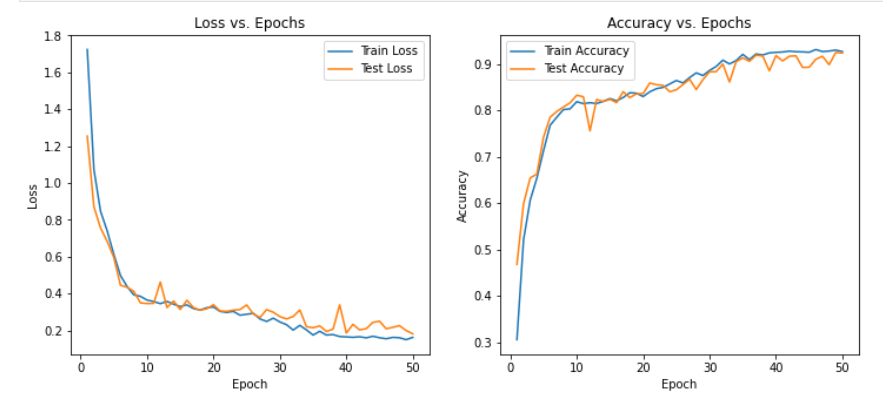
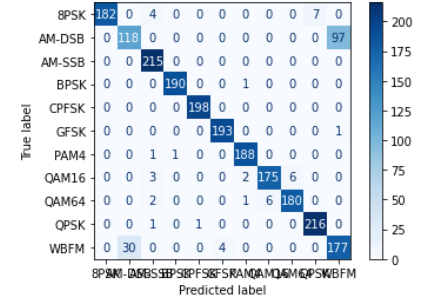
四、對比
1、論文1
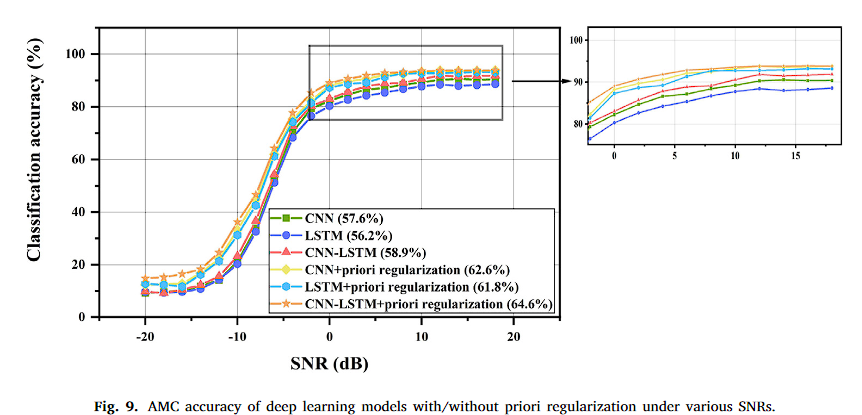
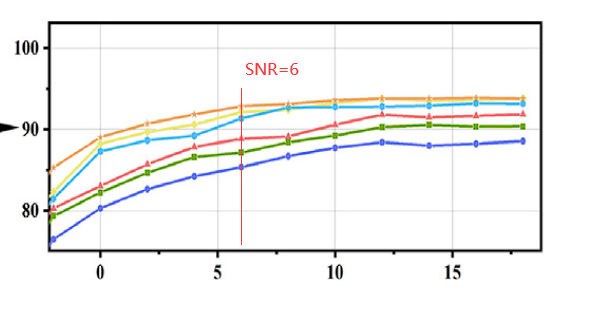
本文的實驗結果和論文1的結果比較類似,即使without priori regularization
2、論文2
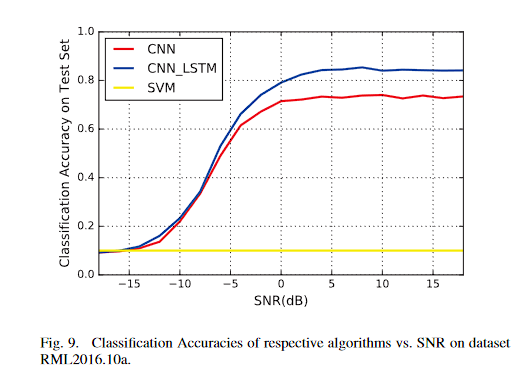

五、總結
- 對于RadioML2016.10a數據集來說,在信噪比不是特別低的情況下,使用CNN就表現的不錯,在SNR=6dB可達91.82%,但是這里有個小技巧,在卷積過程中,先單獨對IQ分量進行卷積,在convolution 4進行聯合處理,一開始就使用2x2的卷積核效果較差。
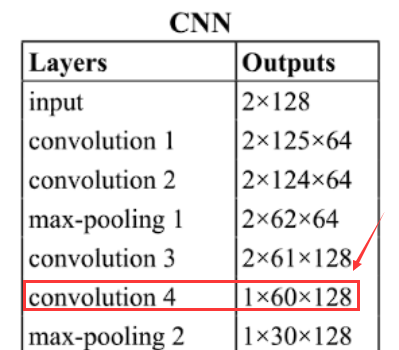
- 實驗結果表明,CNN+LSTM 優于 CNN,但漲幅不多


- 完整的代碼和數據集在GIthub:https://github.com/daetz-coder/RadioML2016.10a_Benchmark,為了方便使用,IQ分量保存在csv中,且僅提供了SNR=6dB的數據,如果需要更多類型的數據,請參考https://blog.csdn.net/a_student_2020/article/details/139800725




- 主成分)

: 源碼分析之異常類spdlog_ex)






中實現部門及子部門用戶查詢的SQL邏輯解析)


)


:JVM虛擬機內存模型)